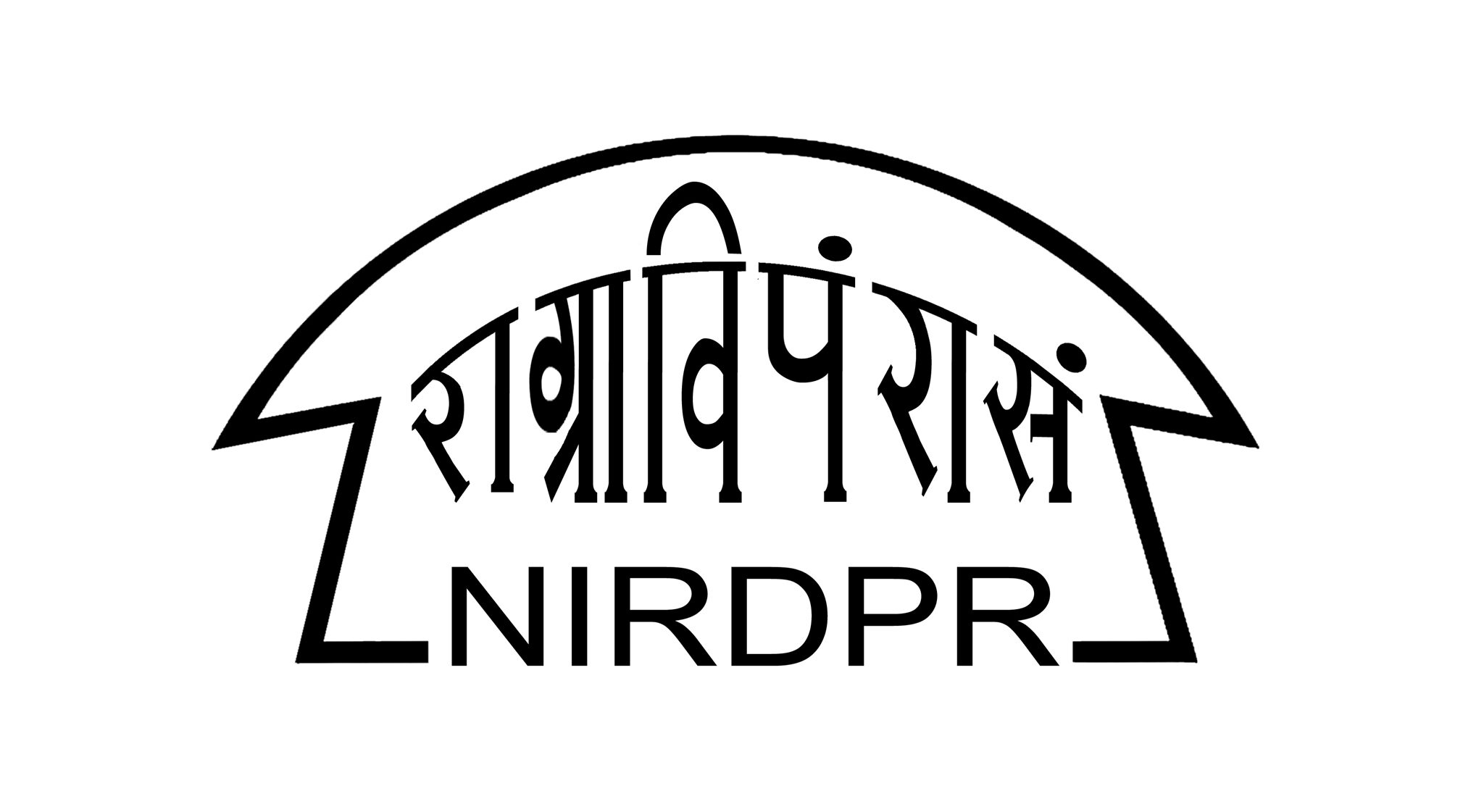
CONTENTS:
Cover Story: Social and Behaviour Change Communication (SBCC) in Rural Development
Five-day Training Programme on Principles of Organic Farming, Certification and Marketing
National Consultative Workshop on Capacity Building of Stakeholders for Educational Development in Rural Areas
NIRDPR-Delhi Branch Conducts Webinar on Rural Transformation through Innovations and Infrastructure Beyond Industry
National Workshop on Strategies for Linkages of SHGs and their Products with Exports and e-Commerce
Two-day Training of Trainers on Social Audit of Rural Development Schemes at NIRDPR-NERC
NIRDPR-NERC Conducts Soft Skills Training for Assam Sericulture Department Officials under World Bank Project
NIRDPR Faculty Identified as Mentor for Mentorship Programme of Asian Institute of Management, Manila
SIRD/ETC CORNER:
Activities of SIRD&PR Mizoram for the Month of July, 2022
Cover Story:
Social and Behaviour Change Communication (SBCC) in Rural Development
There are many misnomers when something that we acquire at an early age and that comes to us naturally is studied. Communication, as a birth right and an expression so explicitly displayed by humans, is often conveniently taken as an innate quality. What is often misunderstood is that communication is a mere function, tool, strategy or discipline. It is the essence of every domain, subject and expertise. The current article points to the development aspect of communication used popularly in development literature as a tool to bring about sustainable change in behaviour. It delves into the theoretical aspects and genesis of the term, as it is used by health-seeking social scientists. A summation of the popular theories of Behaviour Change Communication (BCC) is discussed, followed by the application of the theory in various dimensions and applications of the issues that comprise rural development.
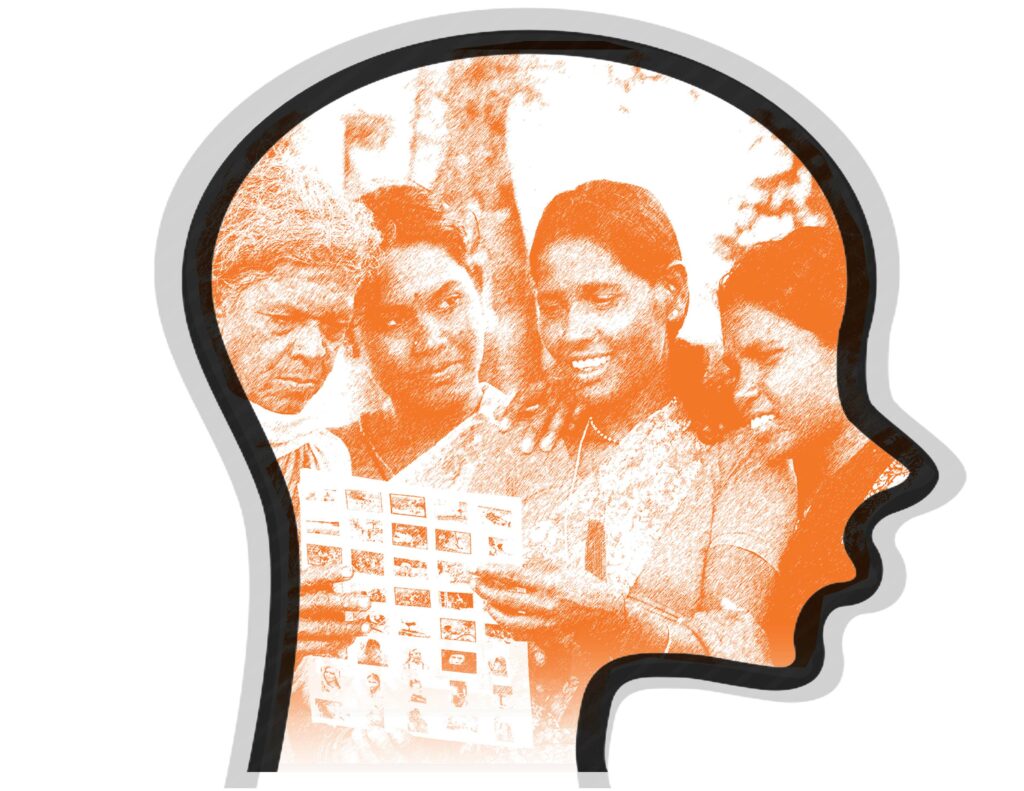
Concept:
Behaviour Change Communication is a communication strategy which encourages individuals and communities to change their behaviour. It is a strategy that triggers people/society/communities to adopt healthy, beneficial and positive behavioural practices. According to S. Nancy and Amol R. Dongre, Health Education (HE) and Information Education and Communication (IEC) gradually evolved into BCC, primarily focusing on creating a conducive environment for promoting behaviour change. Various theories and models operate at the individual, interpersonal, and community levels, explaining the core constructs of behaviour change. According to the Family Health International Strategic Framework: Behaviour Change Communication for HIV/AIDS, Family Health International 2002, BCC is “an interactive process with communities (as integrated with an overall programme) to develop tailored messages and approaches using a variety of communication channels to develop positive behaviours; promote and sustain individual, community and societal behaviour change; and maintain appropriate behaviours.
- In 1792, the concept of health education was developed and extensively used in the 1980s as a cost-effective intervention for disseminating information for the prevention of diseases. It assumed that knowledge determines attitudes, and attitudes, in turn, influence behaviour. Education alone was insufficient to initiate a behaviour change as access to proven preventive measures is needed. In order to plug the existing gaps in HE, Information Education and Communication came into practice in the early 1990s. IEC, as stated by the World Health Organisation, “is an approach which attempts to change or reinforce a set of behaviours in a target audience regarding a specific problem in a predefined period.” It catered to the different needs through various communication tools such as posters, brochures, radio broadcasts, and TV spots. It was assumed that creating awareness would automatically lead to action. IEC gradually evolved to BCC, and it is a part of BCC. IEC is substantially concerned with awareness generation, while BCC goes one step forward and is action-oriented. Theories which explain individual behaviours are the Health Belief Model (HBM), Theory of Planned Behaviour (TPB), and Transtheoretical Model (TTM), while theories which explain group behaviours comprise social comparison theory, social impact theory, and social cognitive theory. Later, BCC was transformed into Social and Behavioural Change Communication as it was seen that behaviours are grounded in a particular socio-ecological context, and change usually requires support from multiple levels of influence, resulting in an expansion of the approach to become Social and Behaviour Change Communication (SBCC).
- To achieve social and behaviour change, SBCC is driven by epidemiological evidence and client perspectives and needs. It is guided by a comprehensive ecological theory that incorporates both individual-level change and change at broader environmental and structural levels, as each is deeply connected (Figure 1).
Figure-1: The Socio-Ecological Model of Behavioural Change

Prominent Theories in BCC:
Two types of behavioural theories are important for BCC programmes—theories of behavioural prediction and theories of behaviour change. Predictive theories address why people change behaviour. They identify what prompts people to perform (or not perform) a health-related behaviour. In contrast, behaviour change theories explain how people change behaviour. They describe the ‘stages’ individuals may go through as they change their behaviour.
Theory of Reasoned Action
The Theory of Reasoned Action suggests that a person’s behaviour is determined, in part, by his/her ‘subjective norm.’ Subjective norm is defined as a person’s “perception that most people who are important to him think he should or should not perform the behaviour in question.” This is called ‘perceived social acceptability.’ The theory provides a construct that links individual beliefs, attitudes, intentions, and behaviour (Fishbein, Middlestadt and Hitchcock, 1994). Here, the following terms are defined as below:
Behaviour: A specific behaviour defined by a combination of four components: action, target, context, and time.
Intention: The intent to perform a behaviour is the best predictor that a desired behaviour will actually occur. In order to measure it accurately and effectively, intent should be defined using the same components used to define behaviour: action, target, context, and time. Both attitude and norms, described below, influence one’s intention to perform a behaviour.
Attitude: A person’s positive or negative feelings towards performing the defined behaviour.
Behavioural Beliefs: Behavioural beliefs are a combination of a person’s beliefs regarding the outcomes of a defined behaviour and the person’s evaluation of potential outcomes.
Health Belief Model
The health belief model stipulates that a person’s health-related behaviour depends on the person’s perception of four critical areas: the severity of a potential illness, the person’s susceptibility to that illness, the benefits of taking a preventive action, and the barriers to taking that action.
Perceived Threat: Consists of two parts: perceived susceptibility and perceived severity of a health condition.
Perceived Susceptibility: One’s subjective perception of the risk of contracting a health condition,
Perceived Severity: Feelings concerning the seriousness of contracting an illness or leaving it untreated (including evaluations of both medical and clinical consequences and possible social consequences).
Perceived Benefits: The believed effectiveness of strategies designed to reduce the threat of illness.
Perceived Barriers: The potential negative consequences that may result from taking particular health actions, including physical, psychological, and financial demands.
Application of SBCC in RD:
The government recognises the need for strengthened preventive services and working with an innovative and results-driven organisation to deliver results at scale. By identifying the solution, investing in human resources, and scaling up its programming, most developing countries reduce their expenses and, more importantly, empower their citizens to improve their health.
Practitioners need ‘ideas and tools’ to work with – not theories as such. Development practitioners need to connect themselves to the context, design messages that are grounded, and deliver messages that result in desired behaviour and social change. It refers to resistance to change and draws ideas from a host of theoretical strands in social psychology to put across how these theories inform development practice, and how they can be effectively used for collective behavioural change in favour of rural development programmes.
For this, it is essential that while formulating messages under SBCC, the following questions have to be kept in mind:
What message goes best with what medium/media?
What is your message?
Who is your audience?
Does it help address the problem?
Does it serve your educational purpose?
What are the programme initiatives?
What is the success ratio?
Why are they not successful?
Why is there a lack of desire to change?
What are the possible solutions?
There have been many initiatives that have founded their communication on the SBCC chain of participatory research and planning, use of transmedia (the same message delivered through audience-specific media), feedback and research, and M&E of SBCC initiatives. UNICEF’s strategy to address adolescent health and other issues faced by adolescents is one such initiative. Jenna Groman, Programme Manager at NetHope opines that data visualisation can be used to convey impactful and compelling evidence that influences behaviour change and improves programme performance by presenting data in ways that are both visually appealing and easy to understand. Visualisation tools, she said, can transform simple spreadsheets or complex documents into easily accessible information that enables users to find answers. SBCC interventions are characterised as those aiming to increase the individual and group practice of optimal nutrition actions within a defined population, working at all levels of the socio-ecological model. A partial list of relevant actors who influence nutrition includes mothers, caregivers, husbands, grandmothers, mothers-in law, healthcare workers, community and religious leaders, district and regional officials, private sector and civil society organisations, the mass media, and policymakers. Communication approaches include interpersonal communication, small, medium, and mass media, and social/community mobilisation, as well as design approaches that incorporate behavioural economics and choice architecture principles. The standard SBCC design processes attempt to identify facilitating or hindering factors related to optimal behaviours (i.e., social norms, gender roles, beliefs, price, taste, or convenience), the variability in resources, analytical and creative skills, experience and in-depth understanding of the target population ultimately limits the impact of these strategies.
Ultimately, the purpose of using communication methods and tools is to engage people and develop strategies for sustainable social and behaviour change. All the above questions, when asked and debated with field functionaries, give viable solutions to problems in the field and suggest correct interventions for improvement in results. Hence, all training must necessarily include this aspect to enhance capacity-building efforts.
Dr. Akanksha Shukla
Associate Professor, CPGS&DE, NIRDPR
Five-day Training Programme on Principles of Organic Farming, Certification and Marketing
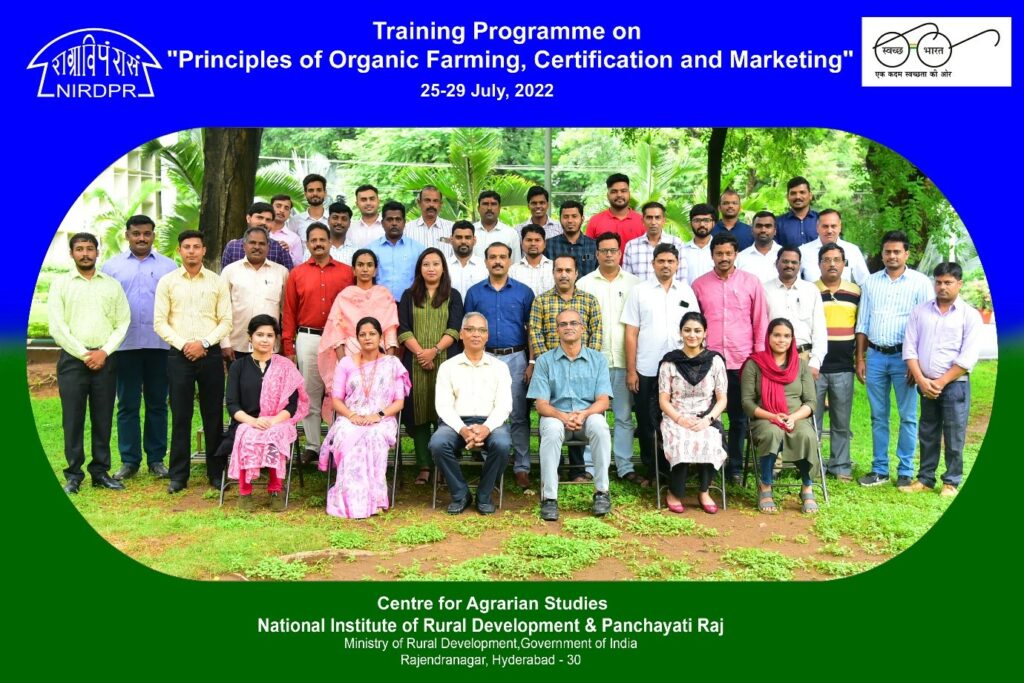
Sustainable agriculture plays an important role in feeding nutritious food to the world’s growing population and reducing the impact of climate change. At the same time, it is a strong felt need that sustainable agriculture is the only way to attain the goal of sustainable development and overcome the adverse effects of modern agricultural practices. Sustainable agriculture “is the successful management of resources for agriculture to satisfy changing human needs while maintaining or enhancing the quality of the environment and conserving natural resources.” Sustainable agriculture is the current emphasis, as farmers are incurring heavy expenditure on intensive farming with the use of inorganic chemicals.
Organic farming is one of the several approaches to meet the objectives of sustainable agriculture. Further, there is a growing consumer preference for residue-free and organically cultivated products. Organic farming has multiple benefits of reduced cost of cultivation, avoiding hazardous chemicals, and premium price for their products and health benefits. Farmers, who have already turned completely organic, have been reaping rich benefits on multiple fronts like improved organic content in their soils, better pest and disease resistance, clean and chemical-free water bodies, and protection to flora and fauna from heavy metal-based chemicals. But the movement is still in the nascent stage, and all stakeholders have to make a quantum leap in terms of coverage of farmers. Therefore, key functionaries from agriculture and allied sectors and rural development need to understand the organic farming practices, certification and marketing to promote and adopt sustainable agricultural practices.
In this context, the Centre for Agrarian Studies of NIRDPR organised a five-day residential training programme on the NIRDPR campus from 25th July to 29th July, 2022 to impart knowledge on organic agricultural practices, process of certification, branding and marketing. The programme aimed to enhance the participants’ knowledge of different sustainable farming methods and practices, understanding the process and management practices involved in organic production, types of certifications, process of certification, and understanding the institutions involved in the certification process. The programme was also aimed to create awareness on the major government programmes and schemes of organic farming and certification and knowledge of branding, pricing strategies and marketing channels.
The programme started with the inaugural address by Dr. Surjit Vikraman, Associate Professor and Head (i/c), Centre for Agrarian Studies. He briefed on the importance of sustainable agriculture, particularly the significance of organic agriculture in the present scenario. Dr. Nithya V.G, Course Director and Assistant Professor, initiated the programme by explaining the background of the training, and modalities, also and briefed about the five-day training programme. The training programme was designed to make it most participatory learning experience for the part with pre and post-training skill tests. A total of five modules were covered in this programme: 1) Farming Practices in India and Models of Sustainable Agriculture Methods, 2) Organic Agriculture: Concept, Scenario, Principals, Practices like input production, package of practice, on-farm resource management, 3) Farmer collectives, marketing and branding strategies of organically grown produce, 4) Documentation, process and certification of organic produce, and 5) Government Interventions to Promote organic agriculture: existing schemes and programmes.
The training was attended by 38 participants, including line department functionaries of agriculture and rural development, FPO implementing agencies, SIRDPR faculty, and SRLM officials. Dr. K. Krishna Reddy, Associate Professor, NIRDPR, Dr. Gagnesh Sharma, Director, National Centre of Organic and Natural Farming, Dr G. V. Ramanjaneyulu, Executive Director, Centre for Sustainable Agriculture, Shri Purushotham Rudraraju, ICRISAT, and Dr. Usha, Vedic Organics were the resource persons, and they delivered lectures on different aspects of sustainable agriculture, organic farming, certification and marketing. The participants were exposed to the initiatives of Rural Technology Park at NIRDPR for promoting sustainable agriculture. Participants were also taken on an exposure visit to Suraksha Farmers Producer Company and organic farms located in Mulugu, Siddipet district, to understand the organic production, certification and marketing process.
Feedback and suggestions from all the participants were taken through Training Management Portal. The participants felt that the course was very timely and useful. They expressed interest in adopting and promoting the organic agricultural practices learnt from the training programme, in their respective areas. The programme was organised by Dr. Nithya V.G., Assistant Professor, CAS and Dr. Surjit Vikraman, Associate Professor and Head (i/c), CAS.
National Consultative Workshop on Capacity Building of Stakeholders for Educational Development in Rural Areas
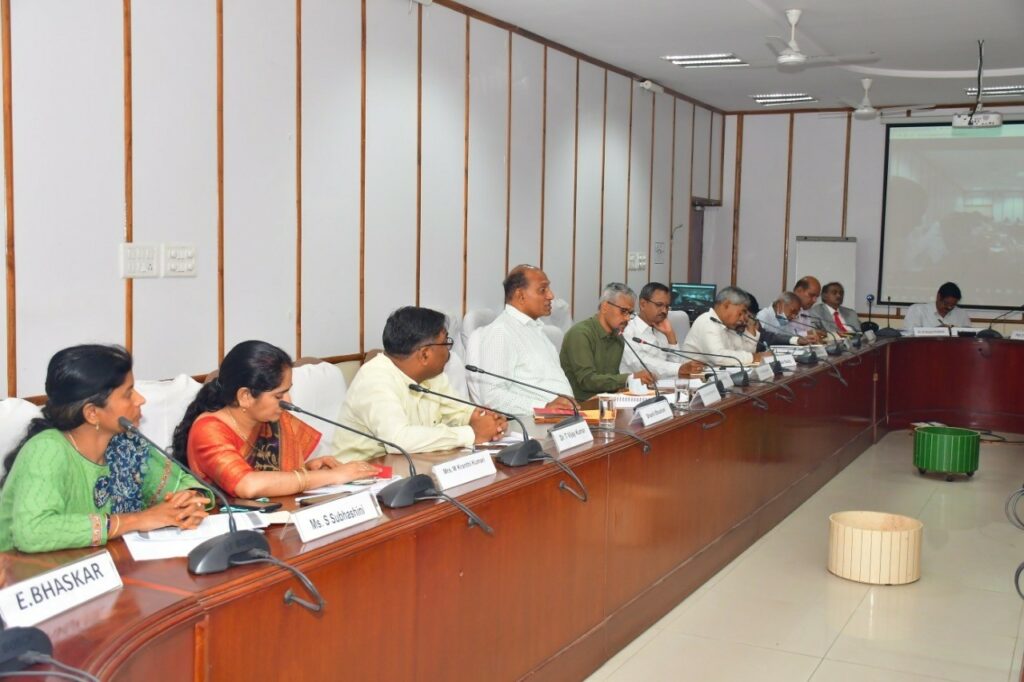
Centre for Human Resource Development, National Institute of Rural Development Panchayati Raj organised a one-day National Consultative Workshop on Capacity Building of Stakeholders for Educational Development in Rural Areas on 27th July, 2022.
The main objective of the workshop was to ascertain the present status of rural education in public/government schools, especially the schools run by Panchayati Raj Institutions, and to discuss the strategies and approaches for improving the quality of education through employment of capacity-building activities. The programme was inaugurated by Dr. Narendra Kumar, IAS, Director General, NIRDPR. Workshop coordinators Dr. R. Murugesan, Prof & Head, Centre for Human Resource Development, Dr. Lakhan Singh, Assistant Professor, CHRD and Dr. T. Vijaya Kumar, Associate Professor, NERC were present.
Dr. Lakhan Singh told the participants that the workshop focuses to discuss on the capacity building of stakeholders for the development of educational facilities in rural areas. Dr. R. Murugesan, Professor and Head, CHRD, while delivering opening remarks, quoted that the quality of education in our country is of great concern. “Students are coming out of colleges with degrees but are not possessing employable skills. In this context, focusing on educational development in rural areas should be a major concern for everyone,” he noted.
Setting the context for the workshop, Dr. T. Vijaya Kumar, Associate Professor and Programme Co-Coordinator, emphasised that improving the quality of education, particularly in rural areas, over a period of time has continued to pose a serious challenge to all stakeholders in the education system. “One of the strategic approaches to improving quality of education is employment of capacity building activities. Bettering the abilities of individuals and organisations to perform functions effectively, efficiently and sustainably in a continuous process is the need of the hour, in the context of achieving Sustainable Development Goal 4, i.e., Inclusive and Equitable Education for all, and also for effective implementation of National Educational Policies such as NEP 2020. In many developing countries, including India, capacity-building activities are conducted in response to ad-hoc requests from the government, mostly the Ministry and Department of Education. However, capacity building has, in fact, developed as a strategic approach to development and as a key feature of education that enables people to address determinants of standards and improve educational outcomes,” he said.
Further, Dr. Vijaya Kumar, emphasised that capacity development needs are to be identified by adopting capacity needs assessment methodology in educational planning and management (CAPNAM approach), particularly in identifying educational policy domains that require planning and management capacities, participatory project management functions to support policy areas and also types of capacities that are required to perform strategic planning, governance and management and empowerment of human resources for educational development in rural areas.
Dr. G. Narendra Kumar, IAS, Director General, National Institute of Rural Development and Panchayati Raj, while delivering the inaugural address, emphasised that education is at the heart of the 2030 Agenda for Sustainable Development. “It is also present as a target under other SDGs on health, growth and employment, sustainable consumption and production, and climate change. Though we have achieved universalisation of elementary education, the quality of education is the biggest concern for us. Many countries are also facing the problem of quality of education. However, our efforts to improve the quality of education are not as good as in other countries. Management of rural government schools is to be focused on, as a large number of schools are located in rural areas. Improving the capacities of these organisational units is of utmost importance to deliver quality education in view of the New Education Policy 2020, and also to achieve sustainable development goals,” he said.
The Director General further stated that PMGSY has expanded road connectivity in every Gram Panchayat. “Therefore, this workshop can think on consolidation of schools in one place with sufficient infrastructural facilities in order to provide quality education and transportation facility to students to do away with many other problems in rural schools,” he said.
The Director General further mentioned that NIRDPR is advocating the People’s Plan Campaign for the development of the Gram Panchayat Development Plan for Village Panchayats by integrating all other sub-plans of the habitations. “In this context, school development plan also should be integrated with GPDP for setting priority for education and to have coherent linkages with other socio-economic policies at the Panchayat level. Quality of schooling highly depends on Panchayat governance through SMCs. Therefore, capacity development of the all-educational stakeholders of PR institutions and Education department functionaries in a convergent mode and utilisation of social capital, i.e., self-help group women, is very important for service delivery at the school and Panchayat level,” he opined.
This workshop was planned to design various capacity development programmes for stakeholders of education, i.e., teachers, school heads, block and district educational officers and their staff, school management committee members and members of Panchayati Raj Institutions. Discussions were held on five thematic areas, such as i) the status of government schools: issues and challenges, ii) planning, service delivery and improvement of grievance processes, iii) curriculum leadership and school-based management for delivery of quality education, iv) transparent, participatory school management support system and implementation, and v) partnership management: coordination and mentoring and preparation of action for capacity building of stakeholders.
A total of 30 delegates from different States, including Professors from NIEPA, NCERT, SCERT and State Project Directors of Samagra Shiksha, officers from State Education Departments, Professors from Central and State Universities, Chairpersons from Zilla Parishad and Mandala Parishad/Block Panchayat, Block Development Officers, head teachers, teachers working in rural schools, and functionaries of NGOs and CBOs attended this workshop and deliberated on various issues related to the development of education in rural areas and working out capacity building programmes for various stakeholders.
Shri Shashi Bhushan, Deputy Director General (i/c), NIRDPR, chaired the valedictory session. In his valedictory address, he emphasised that a few more regional-level workshops are to be organised by NIRDPR to identify the capacity-building needs of the stakeholder for educational development in rural areas.
NIRDPR-Delhi Branch Conducts Webinar on Rural Transformation through Innovations and Infrastructure Beyond Industry
The performance and possibilities of rural transformation through infrastructure and innovations are major issues under Sustainable Development Goal 9. The translation of regional development policies at the top into programmes at the grassroots and vice versa is a complex process. How the community absorbs innovations or benefits from infrastructure remains to be understood. A critical understanding of the government-run infrastructure schemes is needed, and how they perform and in what societal and governance environment they succeed is a crucial question in this regard. To discuss these questions, the 8th webinar of the evidence-based policy and action roundtable was held by the National Institute of Rural Development Panchayati Raj-Delhi Branch on ‘Rural Transformation through Innovations and Infrastructure beyond Industry’ on the 29th June 2022.
Prof. Amrita Dhillon, Kings College, London presented her empirical work on how the States fared in India over two decades on Pradhan Mantri Gram Sadak Yojana (PMGSY) and Mahatma Gandhi National Rural Employment Guarantee Act (MGNREGA). Ranking States by performance can be used to motivate individuals or organisations to improve, therefore, these training exercises have policy and programmatic relevance. The aim is to nudge States towards transformative action in the respective sectors. Prof. Dhillon used publically available data in MGNREGA and PMGSY to link the performance index with possible explanatory variables such as administrative capacity, accountability and level of development.
Following performance indicators are created for MGNREGA.
- Demographic Coverage:
- In a year, how many people were covered
- Measure the demand for employment raised by people
- States having higher BPL adult rural population
- Financial coverage:
- Amount of money spent (accounting for wages and prices difference across the States)
- Intensity:
- Average no. of days worked per programme participant
- Inflation-adjusted average yearly payment per programme participant
The States were ranked on the basis of composite indicators. Each indicator was equally important, and if a State did poorly on one but very well on another, it would get a lower rank. Prof. Dhillon presented that demographic coverage seems to be high in most of the States, but there is considerable variation. Variation is highest in financial coverage; the intensity indicators are less variable between States. Coverage was found to be low for the SC-ST communities. In the dynamic analysis, it was found that there is convergence across the States over time. For example, West Bengal improved on intensity, and Andhra Pradesh and Punjab improved on coverage.
Under PMGSY, her team selected five aspects: road completion rates, cost efficiency, contractor concentration, timeliness and quality completion rate for new and upgraded roads. Cost efficiency was calculated for new and upgraded roads on the basis of expenditure per kilometre of the completed road, which is deflated using the State-wise consumer price index. Contractor concentration was based on the tenders received at the district level, defined as the sum of squares of the market share. The data showed that cost efficiency and timeliness of completion did not correlate in the States. For example, in terms of completing the roads, Madhya Pradesh was at the top, but in terms of cost efficiency and timeliness, it was close to the bottom. Supply-side factors like the State’s capacity to provide goods, level of development politics, and demand-side factors like demand for good quality accountability, elite capture, and rural wage growth influenced the results.
The session was followed by a presentation by Mr. Tomas Stenstrom, International Labour Organisation, who demonstrated the model and global case studies on generating Livelihood through Road Maintenance. Maintenance reduces the vehicle operating cost and provides safe and reliable transport services for road users, and acts as an instrument for poverty alleviation. There are global examples of achieving livelihood goals through road maintenance work in Germany, Lebanon and Nepal, where community groups have been involved in road maintenance and, in turn, generated workdays. In India, ILO is providing assistance in developing maintenance and policy guidelines at both national and State levels on road maintenance to develop and deliver training for engineers and contractors and road maintenance works. The effectiveness of PMGSY across States can be substantially improved if States follow a convergence model by generating livelihood through PMGSY maintenance work.
The presentations were followed by a productive discussion involving professionals and scholars belonging to different disciplines. The webinar was moderated by Dr. Ruchira Bhattacharya, Assistant Professor, CSR, PPP and PA, NIRDPR- Delhi Branch and Dr. Partha Pratim Sahu, Associate Professor, CEDFI, NIRDPR.
Click on the link below to watch the video:
National Workshop on Strategies for Linkages of SHGs and their Products with Exports and E-Commerce
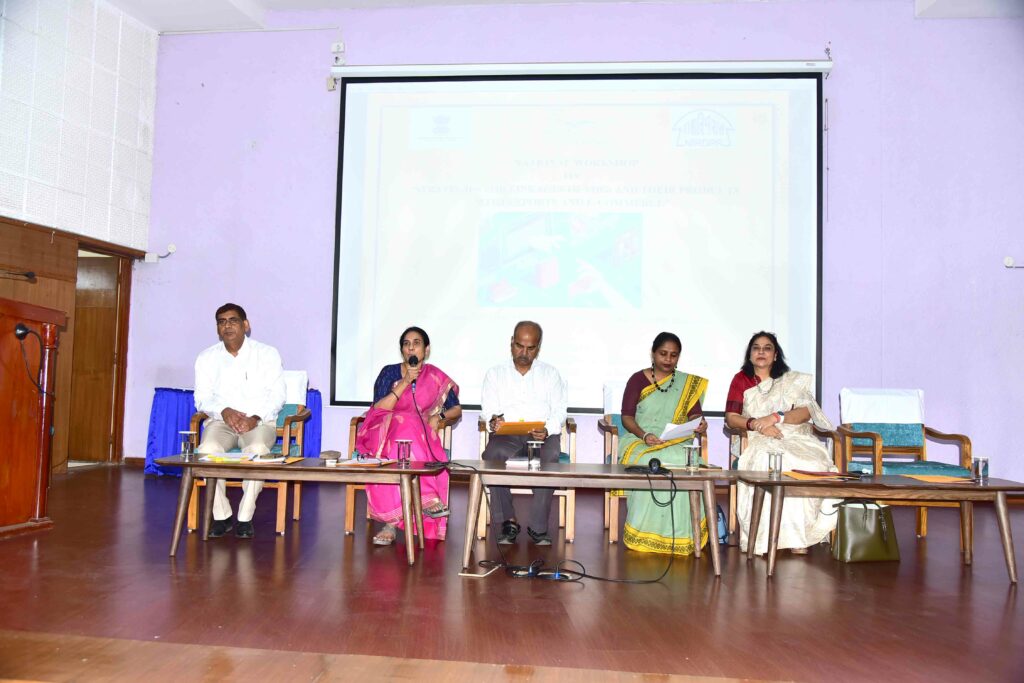
A national workshop on strategies for linkages of SHGs and their products with exports and e-commerce was held on 20th June, 2022, at the National Institute of Rural Development and Panchayati Raj, Hyderabad. The basic objective/purposes of the workshop were to discuss best practices of e-Marketing, review prospects of e-marketing for different rural products and prepare strategies with ways and means for collaboration with potential e-marketing agencies and export agencies. A total of 60 participants from 20 States participated in the workshop.
The workshop started with a welcome note by Shri Chiranji Lal, Assistant Director, CMPRPED, NIRDPR, Delhi Branch. Opening remarks were given by Dr. Ch. Radhika Rani, Director, NRLM-RC and Head CMPRPED, NIRDPR, Hyderabad. Dr. Ch. Radhika Rani briefly explained the structure of NIRDPR and told that five to six centres of NIRDPR are directly or indirectly working for SHGs. “This apart, the NRLM Resource Cell in NIRDPR exclusively works under the DAY-NRLM scheme of MoRD and caters to the capacity-building needs of SHGs for all the SRLMs. Also, the Centre for Marketing & Promotion of Rural Products & Entrepreneurship Development (CMPRPED) is exclusively working on the marketing & promotion of SHG products from the NIRDPR Delhi Branch,” she said.
Dr. Ch. Radhika Rani said that the SHG is a four-decade-old institution and has been evolving over a period of time – from IRDP to DWCRA to SGSY and now DAY-NRLM. “Unfortunately, the efforts taken in these programmes to focus on livelihood could not produce the expected results. It has been observed that there are certain programmes under farm livelihoods like MKSP under Non-form Livelihood Aajeevika Gramin Express Yojana (AJEY), Start UP village Entrepreneurship Programme. However, unless they have continuous support for marketing, these programmes will also not take off in the long run. So, there is a constant effort to provide marketing support for SHGs by the Ministry through the marketing centre of NIRDPR, Delhi Branch, in the form of SARAS Melas. The marketing centre NIRDPR, Delhi Branch organises five to six National Level SARAS Melas on a large scale every year on behalf of MoRD, but it has been observed that once the SARAS Mela is over, they don’t have any platform to sell their products,” she observed.
“Through the State Programme Coordinators, well-functioning SHGs are identified for SARAS Melas. They sell their products only in SARAS Melas, and no organic linkages exist for exploring prospects for sale of products. Therefore, this workshop is being organised to take suggestions on the ways to continue our marketing efforts for sale and promotion of the products of SHGs in the long run, review prospects of e-marketing for different rural products, and prepare strategies with ways and means for collaboration with potential e-marketing agencies and export agencies,” she said, adding that the outcome of the workshop would help to finalise the way for export and e-marketing platform for SHGs.
Shri Shashi Bhushan, Deputy Director General (i/c), NIRDPR delivered the keynote address. Stating that the institutional building of SHGs and financial linkages with banks have taken place in the country, he said the capacity building of SHGs for value chain development, better packaging & designing, communication skills, e-marketing and export marketing are required. “The marketing centre of NIRDPR, Delhi Branch is already trying to build the capacity of SHGs in these skills, so as an exercise of this curriculum, this workshop has been designed to discuss best practices on e-marketing, prospects of e-marketing and prepare a roadmap for marketing of SHG products through various e-commerce platforms and export marketing,” he added.
Ms. Archana P. Wankhede, IAS, Administrative Officer, SRLM, West Bengal, addressed the participants and said that many SHGs fail to get the opportunity to participate in SARAS Melas or sell their products physically as it is not possible to give the opportunity to all SHGs to participate in SARAS Melas or any other similar fairs. “So, in the era of technology, it is possible to onboard all the potential SHGs and their products under various e-commerce platforms. Through these e-marketing platforms, many potential SHGs will be benefitted,” she said.
Shri Ramu Eluri, Kalgudi, Telengana handled the first session on ‘Sharing Best Practices of e-Marketing.’ Shri Ramu Eluri said that lakhs of SHGs are being promoted under NRLM, and many have been promoted before NRLM across the country. “The SHGs have been given multiple doses of loans for their well-being, livelihood promotion as well as their enterprise promotion. They are selling their products, but here we have to discuss the opportunity to sell their products online. By 2024, there will be 8 lakh crore opportunities available under e-commerce in India. An 84 per cent growth is envisaged under e-commerce, but the SHGs are missing these opportunities as many groups are yet to be onboarded under e-commerce,” he pointed out.
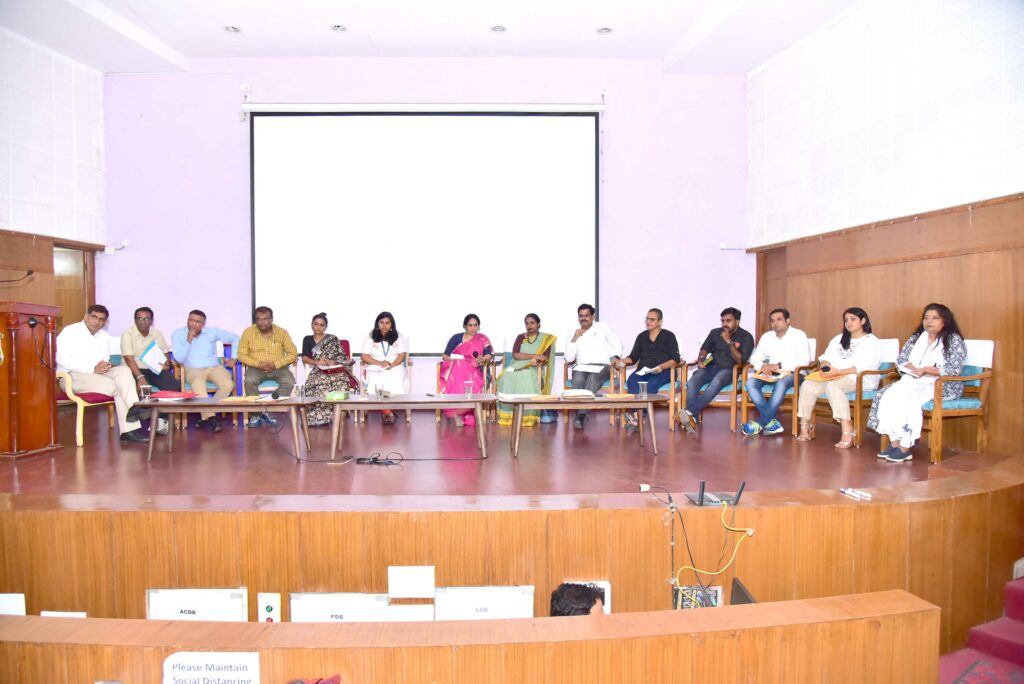
The second session on ‘Prospects of linking of SHG products with e-Marketing’ was taken by Shri Harshal Chadha, Senior Business Manager, FDRVC. He said that owing to the increasing Internet user base and favourable market conditions, India has a lot of potential in the e-commerce industry. “Growing at an exponential rate, the market value of the e-commerce industry in India was approximately Rs. 1,71,000 crore in 2018. This number was estimated to reach Rs. 15 lakh crore by 2027, which is an eightfold increase. Post-Covid, e-commerce has taken hold of the market scenario. Many small & big formats of single-label marketplaces have come into existence. The e-commerce sector has also witnessed certain major mergers too. Support for the artisan community is a global trend, and India is the hub of artisan community. It is one of the top sourcing hubs for artisanal products for exports and international markets. The presence of online stores is required. SRLMSs should also promote their own e-commerce platforms. However, a national-level e-commerce platform like SARAS is required,” he said.
He also listed the following online e-commerce platforms for various products.
| Ecommerce Platform | Products Categories |
| Go Coop | sarees, apparel, home decor, stationery, Gift |
| Craft Bazaar | clothing, jewellery, home decor, bags |
| Bunawat | saree, blouses, suits, |
| Gaatha | jewellery, suits/ sarees, footwear, bags/purses, stoles/shawls, handprinted T-shirts, jackets, skirts, dress material, home décor |
| Spectrahut | home decor, kitchen accessories, handmade lamps |
| The Art Exotica | baskets, bags, cutlery, bamboo products, cushions, stone products, pottery |
| Okhai | dresses, kurtis, sarees, tops, fabric, jewellery, bags, purses/ pouches, stationery, home décor |
| The Indian Craft House | clothing, bags, jewellery, accessories, stationery, (clipboards, diaries etc.) |
| The Kopai Par | scarves, apparel, mats, runners, cushions, bags, baskets, ceramics |
| Craftsvilla | sarees, handcrafted gift items, Home decor, Accessories |
| Mirraw | sarees, suits, lehengas, jewellery, home décor, |
| Limeroad | suits, sarees, bags, home décor |
| Etsy.com | clothing, footwear, home décor, decorations, toys, accessories, sculptures, paintings, etc |
| Qtrove | home decor, other decorative items, bags, wallets, footwear, gift boxes and hampers |
| Coppre | photo frames, trays, vases, platters, boxes, furniture, basketry, etc. |
| Arty Owl | home decor, clothing, accessories, bags, footwear, stationery, art |
| Amazon Handmade | clothing, home & kitchen, footwear, accessories and government emporiums |
| Tjori | apparel, footwear, bags, decor, and jewellery |
| Lal10 | home decor, apparel, bags, lighting, home furnishing, home and office |
| Jaypore | apparel, fashion accessories, home decor, soft furnishing, jewellery, gifts |
| Craftizen | festive products, home decor, toys & games, masks, garments, customised corporate gifts, stationery, bags, jewellery and accessories |
The third session on ‘Sharing experiences on e- Marketing of SHG Products’ was taken by representatives of e-marketing agencies Flipkart, Amazon & GeM. Shri Dhananjay and Shri Abhilash from Flipkart led a very interactive session and cleared the doubts of State Representatives of SRLMs in respect of onboarding, ordering, and logistics issues faced by SHGs. Shri Shailendra, Amazon and Shri Ravi Verma, GeM took a very interactive session and cleared all queries of participants related to the registration process/onboarding of SHGs and their products under Amazon Saheli, & GeM.
The fourth Session on ‘Sharing experiences related to export marketing of SHG Products’ was taken by Ms. Madhu Tyagi, National President & Director, Confederation of Women Entrepreneurs of India (CoWE), Hyderabad. Ms. Madhu briefly explained the norms and standards required for entering into export marketing and the quality required for export. She said that in 2022, the Indian e-commerce market is predicted to increase by 21.5 per cent, reaching US$ 74.8 billion. The Indian e-commerce market is expected to grow to US$ 188 billion by 2025, and by 2030, it is expected to reach US$ 350 billion. For e-commerce, the SHGs should have an online presence, ability to make monetary transactions, and deliver goods and services either online or offline. The SHGs/SHG Federation can create their own website for e-commerce like Shopify, WordPress, etc., or through e-marketing agencies like Flipkart, Amazon, etc.
In the end, each State was told to should identify the list of products with export potential. The products are to be in the following categories, i.e., handicraft, jewellery, handloom, textile, food products and health & hygiene/wellness productsa decision was taken to organise a series of thematic workshops on the above categories in the coming months (July-September, 2022) by CMPRPED, NIRDPR, Delhi Branch.
Two-day Training of Trainers on Social Audit of Rural Development Schemes at NIRDPR-NERC
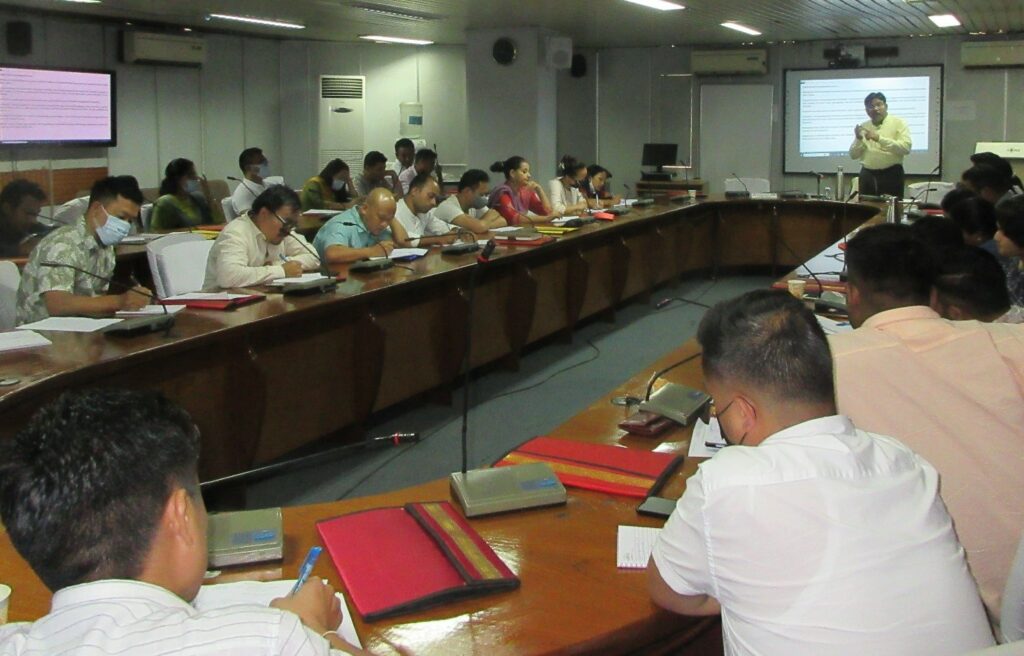
The National Institute of Rural Development and Panchayati Raj-North Eastern Regional Centre, Guwahati organised a two-day training of trainers programme on Social Audit of Rural Development Schemes for all the eight States of the northeastern region of India, from 11th-12th July, 2022.
The main objective of the training programme was to create a pool of skilled trainers expected by the Department of Rural Development to carry out social audit process of development sector effectively in the northeastern region.
The programme was inaugurated by Dr. R. Murugesan, Director, NIRDPR-North Eastern Regional Centre, Guwahati, in the presence of Course Directors Dr. Ratna Bhuyan and Dr. T. Vijaya Kumar.
Welcoming the participants, Dr. Ratna Bhuyan, Assistant Professor and Programme Coordinator, NIRDPR-NERC, said that this programme is mandated by the Ministry of Rural Development to NIRDPR to build the capacities of the North Eastern States Rural Development Department with a pool of trainers, who are trained on the process of social audit across the different rural development programmes. She further emphasised that social audit, based on the principle of local governance, is carried out with the consent and understanding of all stakeholders.
Dr. R. Murugesan, Director, NIRDPR-NERC, delivered the opening remarks and said that social audit training is significant for the effective delivery of rural development programmes. “Training of Trainers in eight States of the northeastern region on social audit will have an impact on governance, and it will give access to marginalised sections of the society in local planning, collective decision-making and accountability,” he said.
While setting the context for the programme, Dr. T. Vijayakumar, Associate Professor and Programme Co-Coordinator, NIRDPR-NERC, emphasised that social audit as a tool, measures, evaluates and identifies the gaps in service delivery. Social audit is being adopted organically by all States for the promotion of participative governance in rural development sector. Citizens can use this as a monitoring tool to gauge the effectiveness of the development schemes. The social audit training programme strengthens Jan Sunwai and allows the organisation to evaluate the sustainable roll-out of a scheme. The training of trainers programme will create a pool of resource persons to carry out the process of social audit and empower the citizens of the region to participate effectively in development process. Meghalaya is the first State in the northeastern region to legislate the process of social audit.
The module of this training was designed with a special focus on the RD schemes such as MGNREGA, Pradhan Mantri Awas Yojana – Gramin, National Social Assistance Programmes and Fifteenth Finance Commission grants from the Ministry of Panchayati Raj. A total of 34 participants from eight northeastern States attended the programme.
NIRDPR-NERC Conducts Soft Skills Training for Assam Sericulture Department Officials under World Bank Project
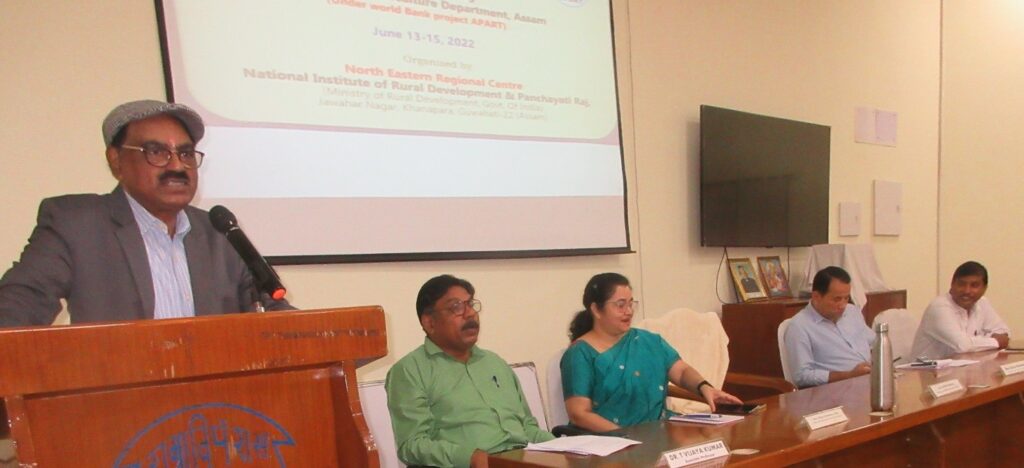
The National Institute of Rural Development and Panchayati Raj, North Eastern Regional Centre, Guwahati, organised a soft skills training programme for the officials of Department of Sericulture, Government of Assam. This was sponsored by Department of Sericulture under the World Bank Project ‘Assam Agribusiness and Rural Transformation Project (APART).’
Smt. Kajori Rajkhowa, ACS, Director, Department of Sericulture, Assam, had approached NIRDPR-NERC to organise the customised skill training to empower the Farmer Interest Groups to promote silk productivity in Assam. The main objective of the training programme was to create a pool of employees, who possess the soft skills expected by the workplace, particularly in the Department of Sericulture. This training module was developed by NIRDPR-NERC to identify the essential soft skills needed by the Sericulture department officials employees for effectively discharging their duties without stress and various activities for their practical training. A total of 100 officials were targeted to be trained by NIRDPR-NERC in three batches. The third batch of training was concluded on 6th July, 2022 wherein altogether 95 officials from 10 districts of Assam have undergone the training programme successfully.
The third batch of programme was inaugurated by Prof. Dibyajyothi Mahanta, Dean, K K Handique Open University, Guwahati in presence of Dr. R. Murugesan, Director, NIRDPR-North Eastern Regional Centre, Guwahati, Shri. Vidyasagar Kudus, Deputy Director, Department of Sericulture and Dr. T. Vijaya Kumar and Dr. V. Suresh Babu, Course Directors, on 4th July, 2022.
Dr. T. Vijaya Kumar, Associate Professor and Programme Coordinator, NIRDPR-NERC, Guwahati, welcomed the dignitaries and participants. He laid focus on the significance of soft skills and mentioned that they are a set of essential competencies that can improve a person’s ability to work with others and even influence how they perform their job.
Dr. R. Murugesan, Director, NIRDPR-NERC, Guwahati while delivering opening remarks, noted that Sericulture is a labour-intensive production system, which can trigger the silk industry with the support of women farmers. “The present government is focusing on skilling of youth entrepreneurs that should be utilised by the Department of Sericulture,” he said.
Setting the context for the programme, Dr. V. Suresh Babu, Associate Professor and Programme Co-Coordinator, NIRDPR-NERC, Guwahati emphasised that the Department of Sericulture Assam has achieved several milestones in the glory of silk Industry. “It is worth mentioning a few initiatives of the department towards sustainable growth and generation of gainful employment through induction of modern technology in enhancing quality and quantity of silk from seed to creation of market linkages to export the silk products. The department has showcased several best practices in the promotion of Eri and Muga silk production, such as 1) Integrated scheme for development of Eri Silk industry in Aspirational district – Baksa under North East Region Textile Promotion Scheme (NERTPS), which emphasises on value addition at every stage of the production chain, 2) Integrated Eri Silk development project for sustainable livelihood to women of BTR through Tapioca Plantation under NERTPS, 3) SAMARTH capacity building and skill development training for Silk Sector, 4) Amended Forest Conservation Act to treat non-mulberry sericulture as forest-based activity enabling farmers to undertake Vanya Silkworm rearing, 5) Catalytic Development Programme – Promoting convergence of sericulture programme with Mahatma Gandhi NREGA, etc. The department has felt necessary to build the soft skills of the officials to achieve the targets as per the National Silk Policy 2020.
Shri Vidyasagar Kutum, Deputy Director, Department of Sericulture, appreciated the training programme feedback received from the participants of the first and second batches. He further stated that the training programme on soft skills would enable the grassroots-level functionaries in mobilising the farmers to strengthen the Farmer Interest Groups.
Prof. Dibyajyoti Mahanta, Dean, K K Handique State Open University, Guwahati, while delivering the inaugural address, emphasised the significance and technology, and development and need for soft skills training to improve the performance of the employees. “This will help in improving the Human Development Index. The Department of Sericulture should document the best practices in sericulture and should develop the material so that it can be incorporated into the school curriculum as emphasised in NEP 2020 for the promotion of rural livelihoods,” he said.
NIRDPR designed the training module on soft skills with 15 technical sessions emphasising the hybrid methodology both in offline and online interactive sessions. The module includes sessions on self-awareness, empathy, creative thinking, critical thinking, decision-making skills, inter-personal skills, effective communication skills, problem-solving, stress and emotional management skills, attitude reconstruction, significance of time management, leadership and conflict management, team building and group dynamics, along with assessment tools for personality development. The follow up of the training programme will be monitored continuously by the professionals of NIRDPR-NERC through online interactions and field visits for a period of six months for equipping the skills. These training programmes were coordinated by Shri Alakesh Malla Baruah and Ms. Kuky Adhikary under the guidance of Smt. Kajori Rajkhowa, Director, Department of Sericulture, Assam.
NIRDPR Faculty Identified as Mentor for Mentorship Programme of Asian Institute of Management, Manila
Dr. T. Vijaya Kumar, a faculty of the National Institute of Rural Development and Panchayati Raj, North Eastern Regional Centre, (NIRDPR-NERC), Guwahati, has been identified as Mentor for the Mentorship Programme of the Asian Institute of Management (AIM), Manila, Philippines.
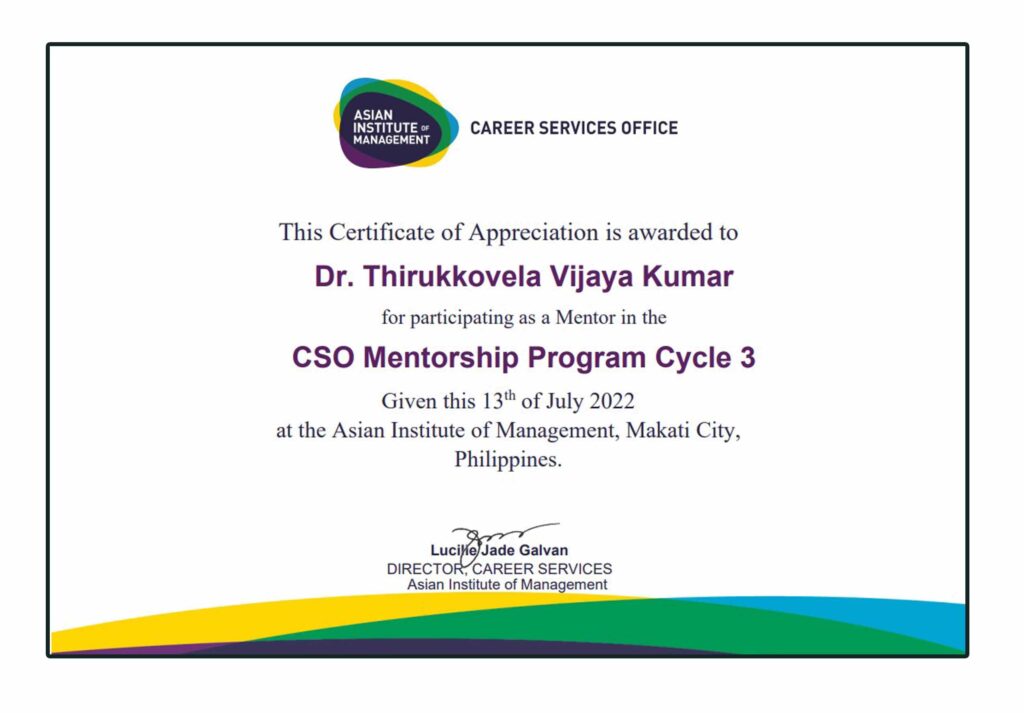
The main aim of the mentoring programme was to strengthen the AIM network and enable alumni, faculty and industry expert from all over the globe to share their professional and personal experience, and expertise with current AIM students of Management Courses. During this programme, Dr. T. Vijaya Kumar has been assigned the mentees of Master of Development Management and Business Administration Courses of 2022. After the successful completion of mentoring programme cycle 3 (January 2022 to July 2022), the AIM awarded a Certificate of Appreciation to Dr. T. Vijaya Kumar for his voluntary mentorship.
SIRD/ETC Corner
Activities of SIRD&PR Mizoram for the Month of July, 2022
The State Insitute of Rural Development & Panchayati Raj, Aizawl, Mizoram conducted a Foundation Training Course for the officials of DRDAs under RD Dept (UDC/LDC/Steno) during 18th – 22nd July, 2022.
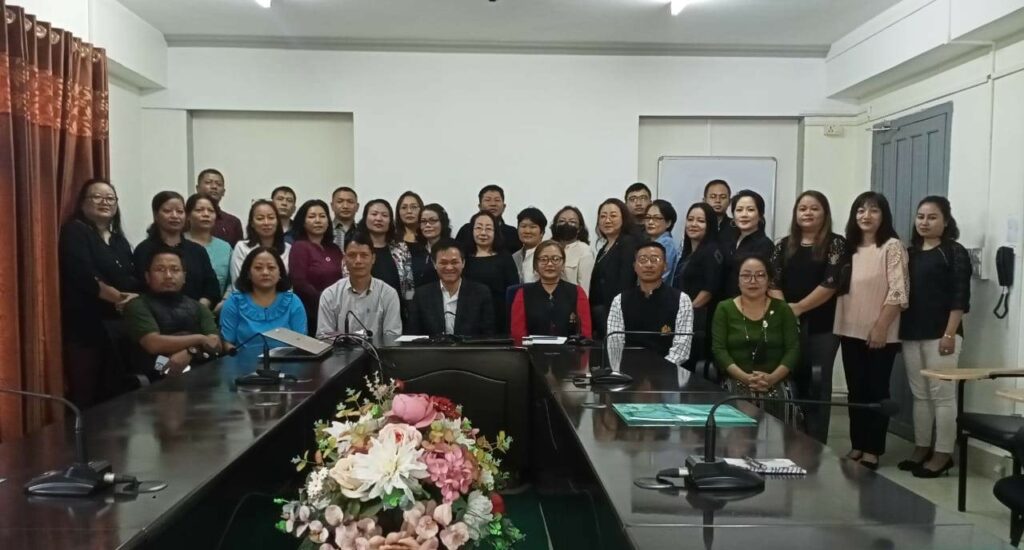
The institute conducted a training session for the officials of Kolasib District on Integrated Financial Management Information System (IFMIS)at ETC, Kolasib, during 13th – 14th July, 2022
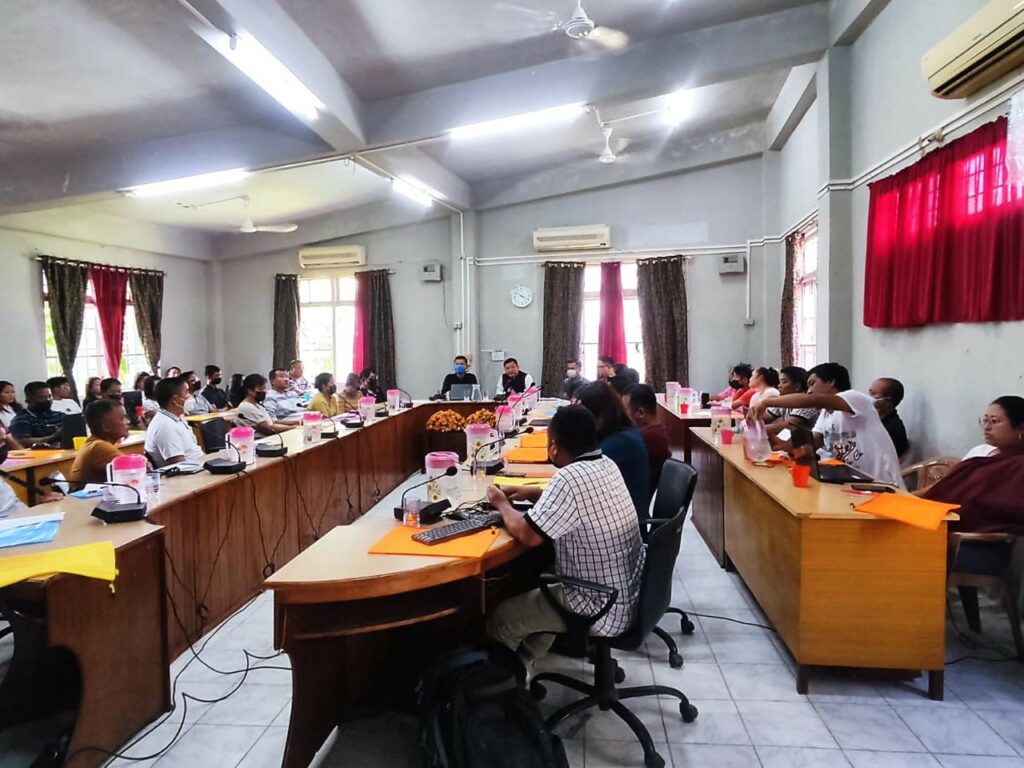
The SIRD&PR Mizoram organised a ‘Career Awareness and Orientation on Entrepreneurship Training for Rural Youth’, at Vaphai Village during 14th – 15th July, 2022.
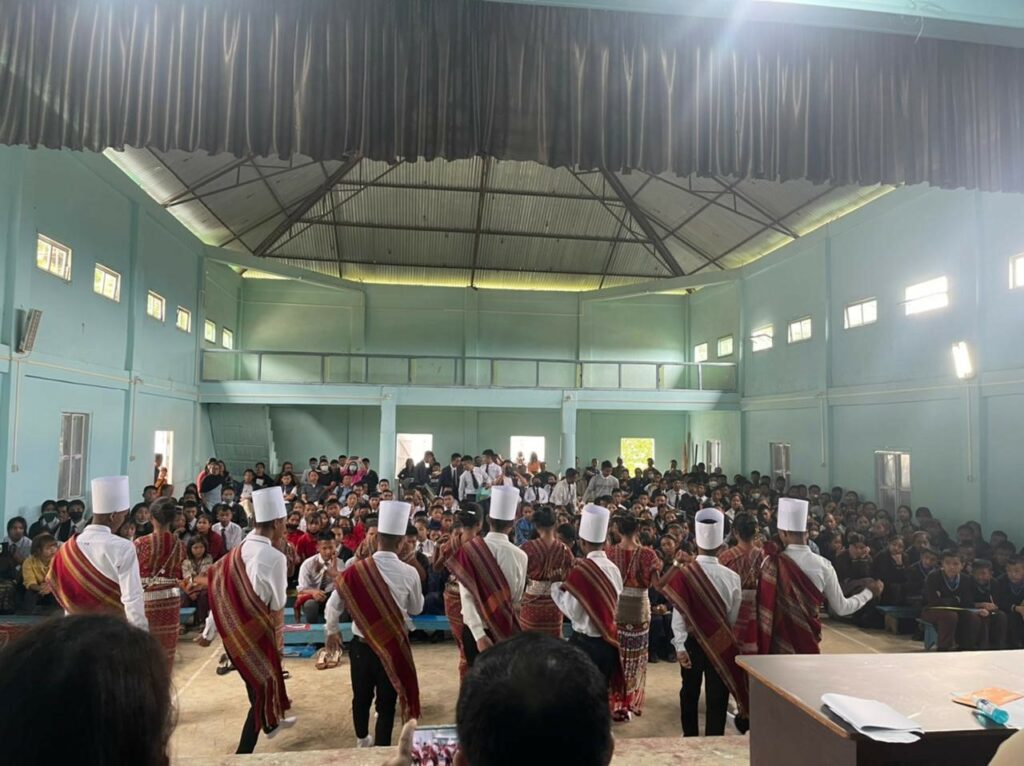
Shri Lalhmunsanga Hnamte, Director, SIRD&PR, Mizoram and Shri Er. Zomawia Hauhnar, Faculty (ET), SIRD&PR, Mizoram, attended the ‘National Workshop on Capacity Building for ODF – Plus’ organised by the Ministry of Jal Shakti, Department of Drinking Water and Sanitation, SBM (G) in New Delhi on 12th July, 2022
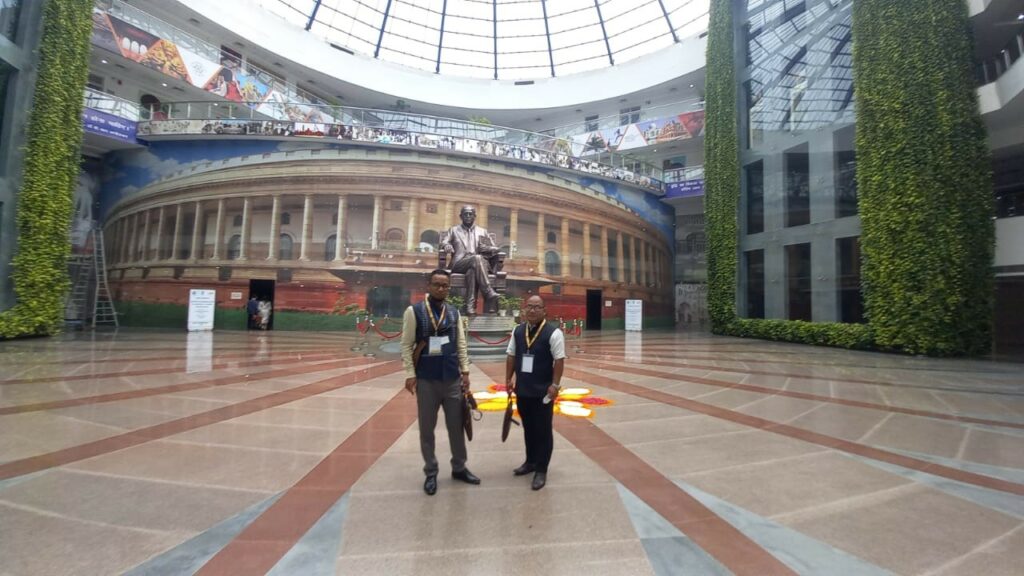
Shri K. David Lalthanmawia, Faculty, SPRC and Shri K. Vanlaldika, Faculty, DPRC, attended a three-day national writeshop to prepare roadmap and draft plan of action to take forward the process of localisation of SDGs at Dr. Ambedkar International Centre, New Delhi during 4th – 6th July, 2022.
